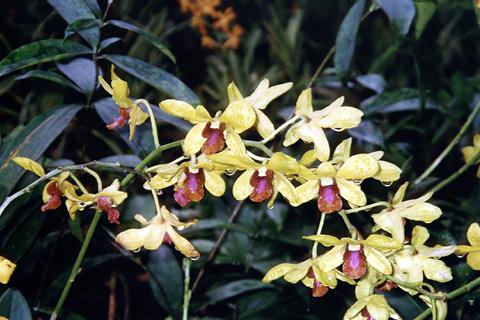
It takes 30 minutes to Kawagoe from Ikebukuro,Tokyo,
when you get on an express train of Tohbu Railway's
Thojo Line, while it takes 40 minutes if you board an
ordinary one of the same line.Ā@
In Edo Era (1603Ā`1867),as Kawagoe had supplied
Edo,one of the world largest city in the modern ages,
with agricultural products and textiles transported
through the newly developed canal called
"Shingashi-Gawa River" by Edo Shogunate, the
culture of Edo City was directly flowing in. It seems
to be why Kawagoe is so smart city.
On top of that, when we look at the last stage of
Muromachi Era (1457Ā`1524), Kawagoe had already
been a developed province. In the period, father Dohshin
and his son Dhokan Ohta who excelled in both
literary and military arts built Kawagoe Castle, while
Edo was still an out-of-way land. Kawagoe is famous
for producing various and especially for high class
confectionaries using sweet potato.
Its population is 330 thousand, and its brightly and
neatly arranged streets and interesting historical places
attract 4 million sightseers a year. There are many
valuable historical places in the city, and the most
renowned ones are the street of dignified shops of
warehouse-design in the center of the city, Kawagoe
Castle and Kita-In Temple. In its premises, there is a
palace in which the court lady Kasuga-no-Tsubone who
nursed the Third Shogun Iyemitsu Tokugawa in his
infancy lived. The palace was disassembled, transported
to Kawagoe from the premises of Edo Castle by
Iyemtsu's donation to the temple about 240 yars ago.
Kita-In Temple is registered as a national treasure. Now
let's go to sightseeing Kawagoe City.
Father Dohshin and His Son Dohkan
Ohta Built Kawagoe Castle 545
Years Ago
A bronze statue of Dohkan Ohta (1432Ā`1486) wearing
hunting cloth stands in front of the City Hall (See Figure
1). Though father Doshin and his son Dohkan built
Kawagoe Castle in 1457, the son was rather well known
for building Edo Castle in a later year when he was so
young as 25 years old.
Dohkan who had deep relation with Kawagoe was an
excellent military commander in the late period of
Muromachi Era.
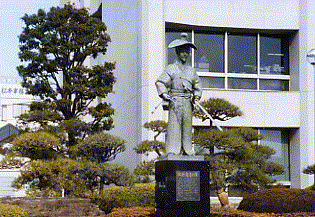 Figure 1 You can see a statue of Dokan Ohta who built Kawagoe Castle with his father Doshin. He later built Edo Castle and lived there. He took effort to transplant Kawage's culture; for example he often held "waka" (Japanese poem consisting of 31 characters) appreciation meetings as he excelled in both literary and military arts. So the present citizens in the city take pride in this fact, saying "Kawagoe is the mother of Edo." |
The explanation board on the pedestal of the statue
tells Kawagoe's history as the following:
| Lord Dohkan Ohta Kawagoe was the center of culture since ancient time. It was called as the mother of Edo, as Ohta Clan built Kawagoe Castle in 1457, furthermore built Edo Castle, and transplanted Kawagoe's culture. Kawagoe had kept the busiest in Saitama Prefecture after Meiji Era. It became the first city in the prefecture in Taisho 11 (1972). We built the statue of Dohkan who was the founder of Kawagoe, cerebrating the fiftyeth Aniversary since then. A proverb says " To know old things is to know new things." September 1972 Mayer Takiji Kato |
At the time he lived, Kantoh District which
included Japan's largest plain was divided into
two parts dominated by Ashikaga Clan and
Uwesugi Clan. And within Uwesugi Clan, two
clans, namely Ohogiya Uwesugi and Yamauchi
Uwesugi Clans were cofronting each other.
Father Dohshin and his son Dohkan Ohta were
retainers to Ohgiya Uwesugi. Dohkan thought
that building Edo Castle where was situated
in the southern deepest point of the domain by
Ohogiya Uwesugi Clan was the best mean for
preventing from penetration by Ashikaga Clan
who had built Koga Castle near to Edo. Dokan
also considered that to form into an alliance
with Yamauchi Uwesugi Clan was a way for
keeping peace for Ohgiya Uwesugi Clan.
Nevertheless, alas how unfortunate Dohkan was
and how foolish his lord Akisada Ohogiya Uwesugi
was! Sadamasa who feared Dohkan's excellent
resources tempted Akisada to kill him, telling
" We are ready to form an alliance, if you kill Dokan".
Akisada was moved by Sadamasa's wicked craft
and he made his retainer suddenly attack Dohkan
when he had come to his lord's castle in the
present Kanagawa Prefecture, who was complying
with his invitation. Sadamasa thus lost his faithful
and excellent retainer Dohkan.
An Episode Tells Dohkan's Nice Character
An episode by Dohkan is well known in this country.
One day, he was caught in a shower when he was
hunting. He found a hovel on his way, walked in and
asked to a young girl who responded him, " Don't you
lend me a 'mino' (rain coat made with strows in old
age) ?". But she laid only a branch of yellow roses
before him in silence. He did not understand what
she wanted to mean and got away with a little bit of
angry.
After returned to Kawagoe Castle, he told his
experience to his retainers and then one close staff
to him said "There is a Waka by a Prince Kaneaki of
Emperer Daigo. His poem sounds (phonetically) in
Japanese:
' Nanaye Yaye Hana wa Sakedomo Yamabuki no Mino
Hitotsudani Naki zo Kanashiki" (which means in English
" Though flowers of yellow rose have seven or eight
folded petals, but how sad it is that they have not even
only one fruit.). Did not she mean that she is too poor
to have even one 'Mino'?
In Japanes language, phrase "Mino (rain coat made with
strows) Hitotsudani" has the same sound as the phrase
does, but its meaning has another one that is "even one
fruit" in English. Hearing this thinking, Dohkan was
ashamed and he learned very much about Waka and he
often held Waka appreciation meetings as I wrote earlier.
Merchants in Meiji Era Left Street
of Dignified Shops of Warehouse
-DesignĀ@
Those who ever have been to Kawagoe, without fail,
refer to the street of thirty several dignified shops
adopting warehouse-design (See Figure 2, 3 and 4).
In Meiji 26 (AD1893), Kawagoe lost one third of the
city by a big fire. At that time, an old house in which
Ohsawa Family had lived and used as a shop selling
'miso' (bean paste) and soysauce since Edo Era solely
remained unburnt even in the middle of the area where
was burnt, because the building was dignified
warehouse-design and on top of it Ohsawa Family
pasted 'miso' on the surfaces of backside of its thick
windows. The Ohsawa Family's warehouse-design
building which you can see still today in the strreet
was built in 1792 in Edo Era. Accordingly the house
has simpler design comparing to the other similar
houses which merchants rebuilt adopting dignified
warehouse-design after this big fire. The street where
more than 30 dignified warehouse-design houses stand
abreast is one of the largest historical places of this
kind in Japan.
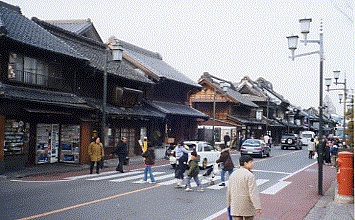 |
Figure 2 These dignified shops of warehouse-design buildings give visitors peaceful and stable feeling. |
| Figure 3 This western-design building was built by Bank Fourty Seventh in 1968 and now used by Kawagoe Branch of Bank Saitama Resona. |
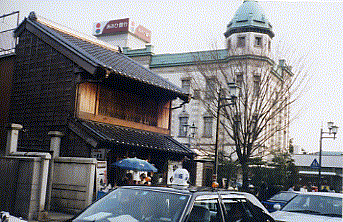 |
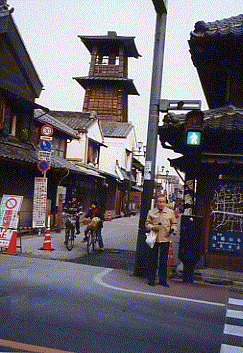 |
Figure 4 Time Telling Tower. The bell has continued to tell time to the citizens for 400 years since Edo Era. But now, an automatic gear strikes the same bell at every oclock. |
Kita-In Temple's Prosperity Came
under Buddhist Bishop Tenkai Who
Served Three Shoguns of Edo Era
Iyeyasu Tokugawa, the founder of Edo Shogunate
had respected for Buddhist Bishop Tenkai, saying
"Bishop Tenkai is Buddha himself among all of the
people who are living now. But unfortunately it was
too late that I came to meet him".
Tenkai acted as the 27th superior of Kita-In Temple
and had lived by 108 years old. His favorite motto was
" Be patient, work hard, be modest to love, eat lightly,
and be generous to every body."
It is said that Iyeyasu had often asked his advices in
his governance of this country. Accordingly Tenkai
served Tokugawa's first three succsessive Shoguns,
Iyeyasu, Hidetada and Iyemitsu. He gave latent
influence upon the early governance of Edo
Shogunate. He also initiated Kan-Eiji Temple in Uweno,
Edo (now Tokyo), which had had the graves of
Tokugawa's successive shoguns.
An episode tells us that Third Shogun Iyemitsu's fortune
was fixed by Tenkai's influence. Second Shogun
Hidetada did not love his eldest son Takechiyo (Iyemitsu's infant name)
because of his poor health, and had intention of making his second son
Kunimatsu sit the seat of the next shogunate. Seeing Hidetada's daily treating
for Takechiyo, Court Lady Kasuga-no-Tsubone aproached Iyeyasu who was then
called "Ohgosyo (Potentate) through Tenkai and made Iyeyasu recommend
Hidetada that Iyemitsu should be the next shogun. Even Iyeyasu retired
from First Shogun, he wield the final power of decision on important matters.
Iyemitsu's donation of the palace Kasuga-no-Tsubone lived, to Kita-In Temple
represents his mind well to treat Tenkai kindly.
The palace building is now used as the temple's guest
building, study building, and the priest living quarters.
The guest building includes "Room Iyemitsu Was Born"
and "Room Kasuga-no-Tsubone Dressed".
You can see all around the guest building(See Figure 5)
by paying the entrance fare \400 (\200 for child).
The entrance ticket icludes the fare for seeing
"Gohyaku Rakan" (Five Hundred Stone Statues of High
Learned Priests) which are standing at a corner of the
premises. They had been carved for fifty years from
1782 to 1825(See Figure 6). Every statue has a
different look.
Kita-In Temple was initiated by Jikaku Daishi ( High
Rank Priest) in 830 in compliance with Emperer Junna's
message and is registered as a national treasure. As to
the cultural properties registered by Japan's
government, the temple is keeping the guest building,
the study building, the priest living quarters, the main
gate, Jigen Temple, the bell tower gate, a yarns winded
sword by Tomonari Tachibana, a copper bell, "Sohban
Issai Kyo" (4,686 Sutras of Song Edition,China), the building of Toshogu
Shrine and Paintings of 36 Kasen (Waka(poem) Experts), and Hiye Shrine.Under
Tenkai, Kita-In Temple was given its domain of more than 150 thousand square
meters and rice of 500 Koku by Edo Shogunate government(See Figure 7).
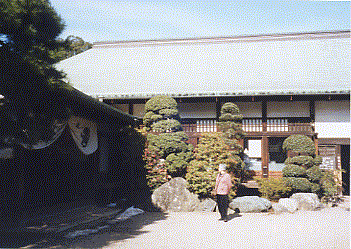 |
Figure 5 The annex palace stood in the site of Edo Castle, and was disassembled and transported to Kita-In Temple from Edo Castle by Third Shogun Iyemitsu's order 240 years ago. |
| Figure 6 Since 1782 these '500 Rakan' (Five Hundred Statues of High Learned Priests) had had been carved for fifty years. No statue has the same look. |
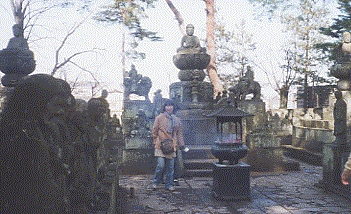 |
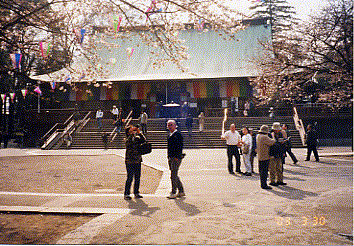 |
Figure 7 On the days a Buddhist mass is held, it is said that several tens thousand to a handred thousand men and women come to worship. |
| Figure 8 The three folded tower is called 'Tahoh Toh' (Tower Keeping Many Treasures). |
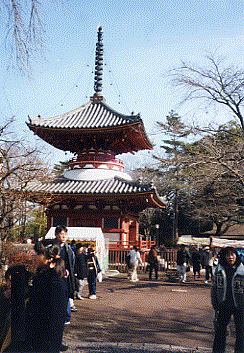 |
Senba Toshogu Shrine, One of The
Three Highest Ranked Shrine
Apotheosizing Iyeyasu Tokugawa
Iyeyasu Tokugawa left his will that his own body should
be burried in Nikko (now in Tochigi Prefecture) after
his death. He died in Shizuoka and the Second Shogun
apotheothized him first in Kunoh Toshogu Shrine on
Mt.Kunoh in Shizuoka Prefecture and later he
transfered Iyeyasu's body to Nikko by building Nikko
Toshogu Shrine.
At that time, his body stayed four days at Senba
Kawagoe and then went to Nikko. As the Third Shogun
Iyemitsu respected his grand father Iyeyasu very much,
rebuilt Nikko Toshogu Shrine to be the most beautifull
shrine by incorporating the quintessence of building
technologies in Edo Era.
When transfering Iyeyasu's body to Nikko, Bishop Tenkai
held a great mass at Senba, Kawagoe,and he built Senba
Toshogu in 1633. Trying to ingratiate with Togugawa
shoguns, many lords had built one of Toshogu shrines in
their own fudal land and it is said that there were more
than 500 Toshogu shrines throughout Japan. However
only 130 of those shrines exist now. Senba Toshogu is
one of the three highest ranked Toshogu shrines among
them (See Figure 9). There are old stone garden
lanterns which succssesive lords of Kawagoe Clan, who
are famous in the history of Edo Era as Nobutsuna
Matsudaira or Yoshiyasu Yanagisawa, donated.
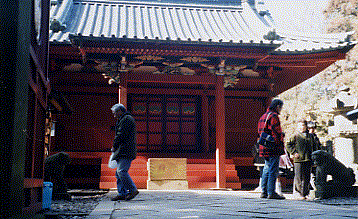 Figure 9 There stand Senba Toshogu Shrine on the top of the hill in the vicinity of Kita-In Temple. The reason of its building was that Bishop Tenkai held a great mass when Iyeyasu's body was transfered to Nikko from Kuno in Shizuoka. |
Quiet Premisis of Naka-In Temple
Has Graves of A Principal Retainer
Taiyoji Family of Kawgoe Land Lord
You can see Naka-In Temple and its vast quiet garden
neighboring on Senba Toshogu. The temple was also
initiated by Jikaku Daishi Priest in 830 and its building
stood on the place Toshogu stans now. Naka-In Temple
was disassembled and moved here when Toshogu was
built. Entering its entrance gate, you will see three
graves of the principal retainer Taiyoji Family to
Kawagoe Land Lord Akimoto on your left.
You will also see the grave of Miki Kato, mother in law
of Tohson Shimazaki, an eminent writer in Meiji and
Taisho Eras her tea celemony house Tohson presented.
Miki was born as the second daughter of Kato who
acted a high retainer of Matsudaira Clan who dominated
Kawagoe domain.
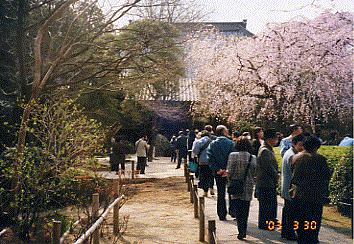 Figure 10 In every spring you can see a fascinating drooping cherry tree in full blossom in front of the main temple. |
Kawagoe City Museum Gives Bird
Eye View of Kawagoe's History
When you walk through the street of the dignified
shops adopting warehouse-design, you will arrive at
Huda-no-Tsuji crossroads(See "the map of historical
places in Kawagoe City" I drew). If you turn to left on
the crossroads and go for a while, you will see Kawagoe
City Hall on your left side soon. Please proceed on the
road furthermore, and you will see a white
warehouse-like one storied building on your left. That
is Kawagoe City Museum (See Figure 11).
The entrance fare is \200 for adult, \50 for child and
\100 for pupil or student (primary, junior, or senior high
schools). If you pay \300, you can also enter Kawagoe
Castle near the museum. The museum is closed on
every Monday.
The museum exhibits "Small Edo Kawagoe" in modern
ages, "How Kawagoe Had Grown" in modern and present
ages, "Acivities of Samurai and Kawagoe" in feudal ages,
"The Dawn of Kawagoe" in genesis and ancient times,
and "Race, Kawagoe's Craftsmen and Aniversary" on
pernent basis, while it often plans special exhibitions in a
room, for example, displaying "How We Lived in the
Imediately after the End of World War II".
In the room "Small Edo Kawagoe", you can see a fine
folding screen which is painted the landscape of
Kawagoe to Edo in the time Iyemitsu governed Japan.
A personel of the museum explained to me that about
5,000 persons were drawn on this huge golden screen
including Iyemitsu himself. You will see an wood-calved
sitting statue of Buddhist Bishop Tenkai at one corner
of the room.
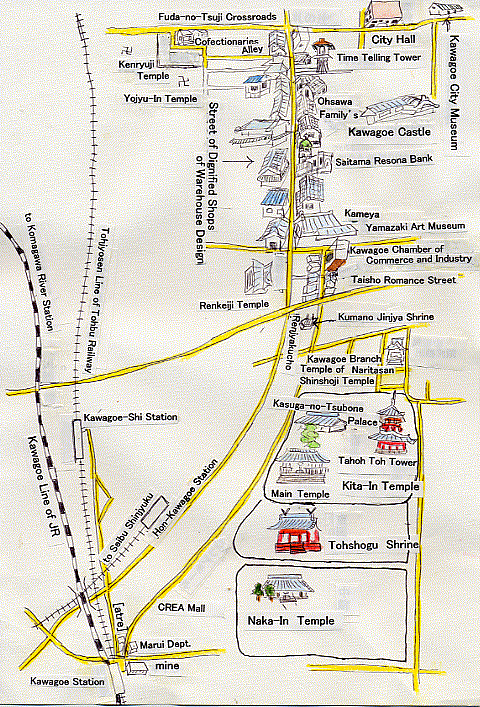 Map of Kawagoe City shows historical places. |
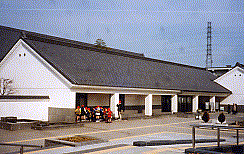 Figure 11 Kawagoe City Museum provides you with a bird-eye view of the city's history. |
The Entrance Part of Kawagoe
Castle Remains Well The Scene
250 Years Ago
Soon after leaving Kawagoe City Museum and turning
the road to right, you will arrive at Kawagoe Castle. This
is also one storied castle. The building is the part of
entrance of the palace built in the main area and passes
us well the scene 250 years ago. As I wrote earlier,
Kawagoe Castle was built by Father Dohshin and his son
Dohkan Ohta 546 years ago (in 1457) in compliance with
Mochitomo Ohgiya Uwesugi's order in order to confront
to Shigeuji Ashikaga who was a brother of Ashikaga
Shogun in Kyoto at that time.
In after years Iyeyasu Tokugawa moved to Kantoh
District who was changed his domain Mikawa to Kantoh
by Hideyoshi Toyotomi, the highest power at the ending
period the age of wars which had continued a 100 years.
After moving to Kantoh, Iyeyasu repaired Edo Castle
temporarily. And after he completed to grisp the highest
power of dominating this country, he greatly expanded
Edo Castle making almost all the land lords construct.
Tokugawa Clan's Shogunate appointed chief retainers
to every land lord of Kawagoe Clan.
When Ohta Clan built Kawagoe Castle, it included only
main area and second one, but Nobutsuna Matsudaira,
a land lord in Edo Era expanded the castle area to
14,000 square meters, including main, second and third
areas, three towers and twelve gates. The areas were
surrounded by double ditches. The present building was
the part of entrance of the main palace consisting of 16
houses which Narinori Matsudaira built in 1848.
The building is now connected with a working house of
the principal retainers. You will see the wax dolls of
them consulting something governmental matter.
In those times, as every land lord of Kawagoe was living
almost through a year in Edo to support the Shogun,
they had to govern people in Kawagoe Clan.
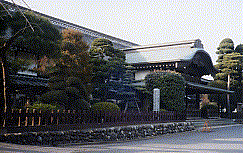 Figure 12 The site of Kawagoe Castle once boasted of 14,000 square meters. The present buildings remains only the entrance part of the palace in the main area, and the office house of the principal retainers. |
A Farmer Initiated Kawagoe Branch
of Shinsyoji Temple Thanking Divine
Favor of Buddha "Hudoumyo-Ou"
When you walk out of the north exit by Tahotoh Tower
of Kita-In Temple and proceed 100 meters, you will find
Kawagoe Branch of famous Naritasan Shinshoji Temple,
in Chiba on your left. The temple was restored in 1853
by a farmer Shouon Ishikawa, based on an abolished
temple.
Shouon Ishikawa suffered from an eye disease and lost
his sight, when he was 30 years old. Disapointed Shouon
was about to commit suicide. At just time, he saw a
Buddha's messenger called "Hudoumyou-Ou"
(Acalanahta) appearing before him. He became to
believe Buddhism and earnestly worshipped
Hudoumyou-Ou. Strangely, his eyes had gradually
recovered sight. He restored an abolished temple as a
branch of Shosinji Temple here. The story is
the oral history of the temple. Interestingly, a flea
market of antiques is held on 28th every month.
 Figure 13 The branch temple of Famous Naritasan Shinsyoji Temple was initiated by a farmer who recieved divine favor of Buddha 150 years ago. |
Dear Old Confectionaries Alley and
Street Performance
There is a dear old confectionaries alley called "Kashiya
Yokocho" in Japanese near Fuda-no-Tsuji Crossroads.
This alley originally was an ordinary shops alley in front
of Yohjuin Temple. It had transformed, however, to a
town more than 70 confectionary shops lined up after
Meiji Era. The shops sold to children cheap sweets such
as wheat glutens, pan cakes with herb leaves, fried
sweet confectionaries, variety of confectionaries using
sweet potato,etc.
It is interesting to see a seller of soft wheat gluten is
made any shape of an object, for example, of a dog, a
fox, a gogira,etc. which customers on the alley request
in a few minutes by the seller. When it is lucky time,
you can see several street performaces such as
"Kamishibai" (Paper-slide picture show) and "Nankin
Kamasudare" perfomance (a performance using bamboo
blind to make verious shapes of some objects) such as
an arch bridge, a river,etc. The alley is jammed with sightseers on holidays or every Saturday and Sunday.
 Figure 14 The dear old confectionaries alley is jammed with sightseers on holidays or Saturday and Sunday. |
Shops of Western Design Stand
Abreast on Taisyo Romance Street
When you walk out of Kawagoe Station of Tojyosen
Line, you will have good impression of coming to
clean and neat city, seeing the seven or eight
storied buildings such as [atre], Marui, mine, etc.
around you. And if you proceed to left side, you
will go down on the entrance of CREA Mall which
is about one kilo meters long, with many modern
shops standing abreast. I have never seen such a
long shopping mall in this country. Needless to
say that you will see many a youngsters, middle
or old men and women, and foreigners are walking
on the shoping mall even on a week day. We can
see many shops of apparels in the city, because
it had supplied Tokyo with textiles in Meiji Era.
The map I described shows only the positions
between the historical buildings and the actual
distance between Kita-In Temple, Toshogu
Shrine, Naka-In Temple and CREA Mall. So it
takes 25 to 30 minutes on foot from CREA Mall
to the historical monuments.
Passing Renjyakucho, you will arrive at Taisho
Romance Street. On this street, you will see
shops of western design in the old good age of
Emperor Tiasho (the next Emperor to Meiji)
standing abreast in both sides (See Figure 15).
There are verious shops such as shops selling
aparrels, Japanese cakes, Japanese dolls, 'Susi' restaurant, eel restaurant, coffee shop,etc.
The building at the deepest corner is Kawagoe
Chamber of Commerce and Industry and is
registered as a cultural property.
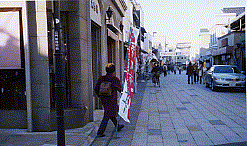 Figure 15 Shops of western design in old good age bring on quiet peaceful atmosphere. The nearest shop sells aparels. |
Spring and Autamn Anniversaries
in a Great Bustle
In spring and autumn anniversaries which are held
in the third part of March and on the thrird Saturday
and Sunday in October every year under extensive
support by Kawagoe City Government are very
prosperous. Both sides of CREA Mall and the street
of dignified shops of warehouse design are completely
filled with open-air stalls.
The explanation I read in Kawagoe City Museum
tells me as to Kawagoe Anniversary as the
following:
"Kawagoe Anniversary began in 1648 under the
encoragement by Land Lord Nobutsuna Matsudaira.
Being given influence by ' Tenka Matsuri' ( Peaceful
Anniversary) in Capital Edo, Kawagoe Anniversary
had been more and more prosperous, and in 1826
ten towns operated their own float and dancing stage,
etc. for competing their brightness and idea.
In Meiji Era, the core of effots of the anniversary
shifted to operate floats of double type, and after
the world war, as the towns operating a float have
increased, Kawagoe Anniversaries in both spring
and fall have become whole city events."
Kawagoe Anniversary in fall is actually the festival
of Hikawa Jinjya Shrine as the whole city deity
shrine which has continued more than 350 years.
At the fesitval, many dazzling floats with a tricking
doll work are operated by almost every town in
thwe city (See Figure 16).
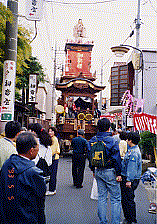 Figure 16 You can see many floats loading a tricking doll work are moving on the streets in Kawagoe Anniversaries in both spring and autaumn. |
September 17, 2003
TO PART 1: MISHIMA CITY
TO PART 2: SHUZENJI TOWN
TO PART 3: NIRAYAMA TOWN
TO KAWAGOE CITY
TO HAGI CITY
TO PAGE SHOWING CONTENTS
YOUR IMPRESSION

